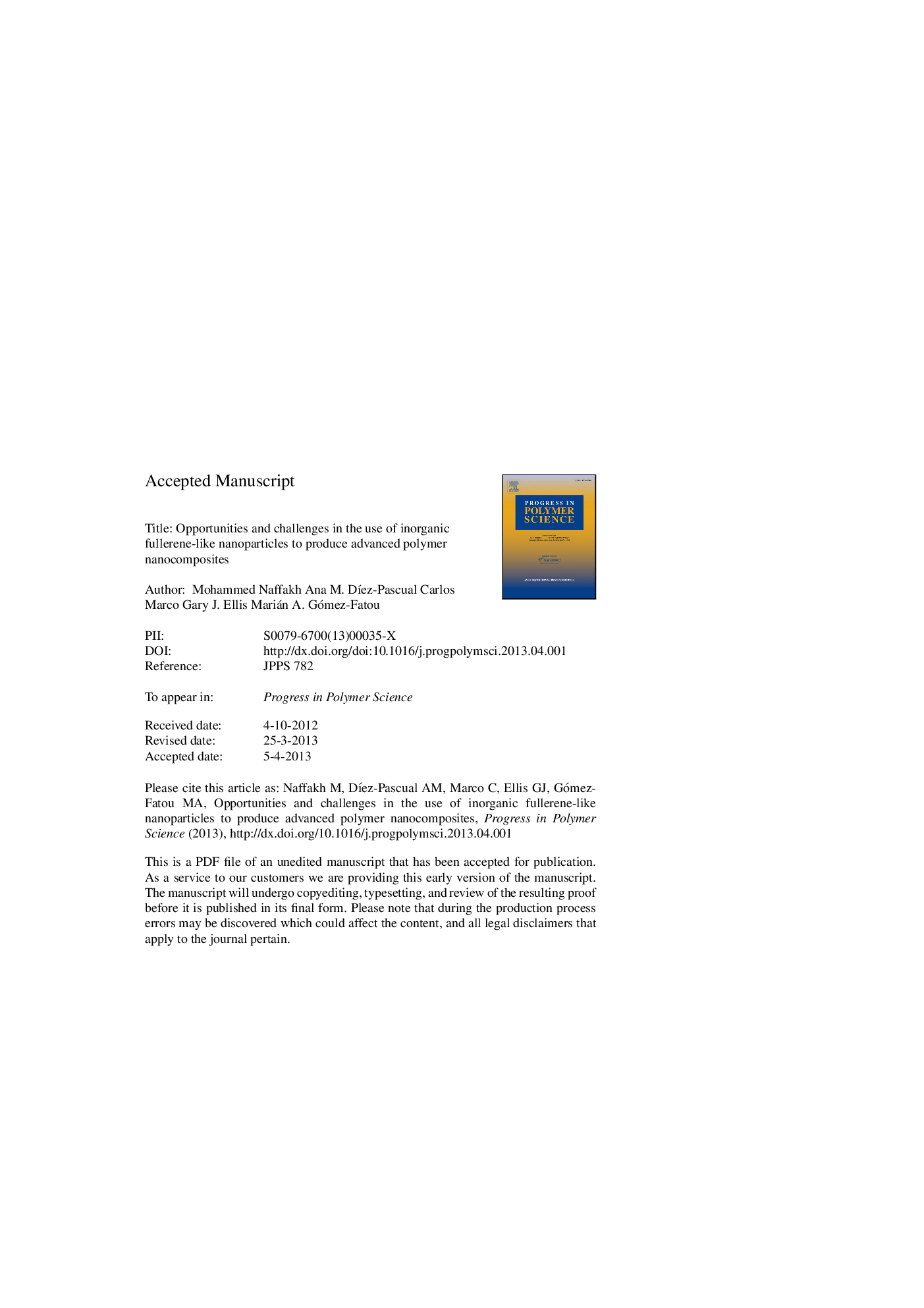| Article ID | Journal | Published Year | Pages | File Type |
|---|---|---|---|---|
| 5208263 | Progress in Polymer Science | 2013 | 201 Pages |
Abstract
Polymer/inorganic nanoparticle nanocomposites have garnered considerable academic and industrial interest over recent decades in the development of advanced materials for a wide range of applications. In this respect, the dispersion of so-called inorganic fullerene-like (IF) nanoparticles, e.g., tungsten disulfide (IF-WS2) or molybdenum disulfide (IF-MoS2), into polymeric matrices is emerging as a new strategy. The surprising properties of these layered metal dichalcogenides such as high impact resistance and superior tribological behavior, attributed to their nanoscale size and hollow quasi-spherical shape, open up a wide variety of opportunities for applications of these inorganic compounds. The present work presents a detailed overview on research in the area of IF-based polymer nanocomposites, with special emphasis on the use of IF-WS2 nanoparticles as environmentally friendly reinforcing fillers. The incorporation of IF particles has been shown to be efficient for improving thermal, mechanical and tribological properties of various thermoplastic polymers, such as polypropylene, nylon-6, poly(phenylene sulfide), poly(ether ether ketone), where nanocomposites were fabricated by simple melt-processing routes without the need for modifiers or surfactants. This new family of nanocomposites exhibits similar or enhanced performance when compared with nanocomposites that incorporate carbon nanotubes, carbon nanofibers or nanoclays, but are substantially more cost-effective, efficient and environmentally satisfactory. Most recently, innovative approaches have been described that exploit synergistic effects to produce new materials with enhanced properties, including the combined use of micro- and nanoparticles such as IF-WS2/nucleating agent or IF-WS2/carbon fiber, as well as dual nanoparticle systems such as SWCNT/IF-WS2 where each nanoparticle has different characteristics. The structure-property relationships of these nanocomposites are discussed and potential applications proposed ranging from medicine to the aerospace, automotive and electronics industries.
Keywords
SWCNTsSiCTMRHMDShexamethyldisilazaneEVASSAPEIIPPSEBSDCPPBAPOEWAXSHRSEMhigh-resolution scanning electron microscopyCNOMAHSDBSUHMWPEPOSST10Polyolefin elastomerGPTMSCFRPsdcMSOMMTPGMADHBPSCFSPNCsPVAHPMCPCLCOFPOMPTFEMWCNTsCNTSDMAPpssPEEKPolyhedral oligomeric silsesquioxaneamino acidEthylene-co-vinyl acetateStearic acidOleic acidMalonic acidCarboxylic acidShort carbon fibersAcrylic acidDynamic mechanical analysisBarium titanateDegree of crystallinityglass transition temperatureMelting TemperatureDicumyl peroxidePEEKsodium dodecylbenzene sulfonateSpecific surface areaSilicon carbideCoefficient of frictionNucleating agentCarbon fiberMaleic anhydrideAPTESOrgano montmorilloniteSingle-walled Carbon NanotubesMulti-walled carbon nanotubesCarbon nanotubesPolymer nanocompositesWide angle X-ray diffractionPoly(ether ether ketone)Poly(butyl acrylate)Poly(tetrafluoroethylene)poly(phenylene sulphide)Poly(glycidyl methacrylate)PolyetherimidePoly(vinyl alcohol)PolypropyleneIsotactic polypropyleneSulfonated poly(ether ether ketone)Polystyrene
Related Topics
Physical Sciences and Engineering
Chemistry
Organic Chemistry
Authors
Mohammed Naffakh, Ana M. DÃez-Pascual, Carlos Marco, Gary J. Ellis, Marián A. Gómez-Fatou,
